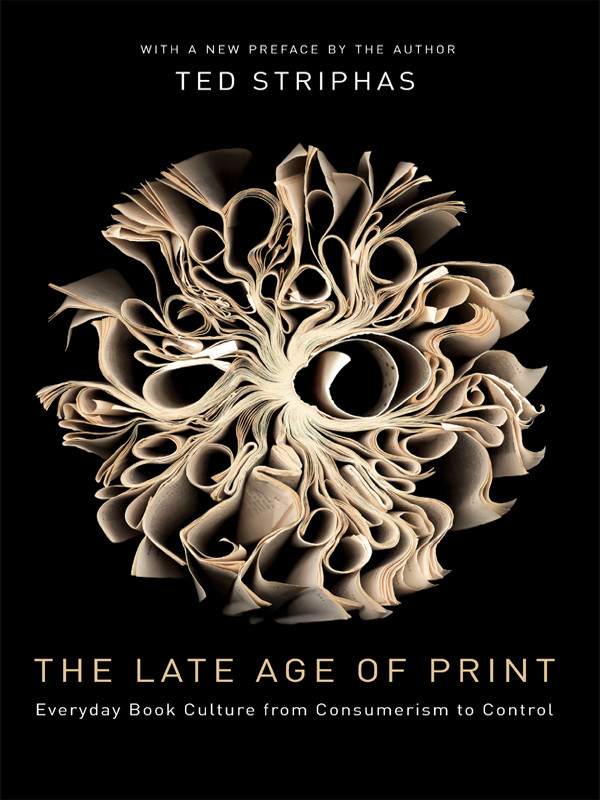Ted Striphas: The Late Age of Print: Everyday Book Culture from Consumerism to Control (2009)
Filed under book | Tags: · book, electronic literature, filesharing, literature, publishing

“Ted Striphas argues that, although the production and propagation of books have undoubtedly have entered a new phase, printed works are still very much a part of our everyday lives. With examples from trade journals, news media, films, advertisements, and a host of other commercial and scholarly materials, Striphas tells a story of modern publishing that proves, even in a rapidly digitizing world, books are anything but dead.
From the rise of retail superstores to Oprah’s phenomenal reach, Striphas tracks the methods through which the book industry has adapted (or has failed to adapt) to rapid changes in twentieth-century print culture. Barnes & Noble, Borders, and Amazon.com have established new routes of traffic in and around books, and pop sensations like Harry Potter and the Oprah Book Club have inspired the kind of brand loyalty that could only make advertisers swoon. At the same time, advances in digital technology have presented the book industry with extraordinary threats and unique opportunities.
Striphas’s provocative analysis offers a counternarrative to those who either triumphantly declare the end of printed books or deeply mourn their passing. He isolates the invisible processes through which books have come to mediate our social interactions and influence our habits of consumption, integrating themselves into our routines and intellects like never before.”
Publisher Columbia University Press, 2009
Creative Commons Attribution-Noncommercial-Share Alike 3.0 License
ISBN 0231148143, 9780231148146
242 pages
Interview with author: Henry Jenkins (2012, Part 2).
Reviews: Steven Poole (The Guardian, 2009), Vicky Gilpin (Southwest Journal of Cultures, 2009), Casey Brienza (Publishing Research Quarterly, 2009), Sarah Lowengard (Technology and Culture, 2010), Jeffrey St. John (Quarterly Journal of Speech, 2010), David Haeselin (Electronic Book Review, 2010), Laura J. Miller (Journal of Consumer Culture, 2010), Sean Johnson Andrews (Reviews in Cultural Theory, 2011).
Book website
Wikipedia
Publisher
WorldCat
PDF (11 MB, updated on 2020-5-19)
EPUB (18 MB, added on 2020-5-19)
Matthew G. Kirschenbaum: Mechanisms: New Media and the Forensic Imagination (2008)
Filed under book | Tags: · digital forensics, electronic literature, forensics, hypertext, literature, materiality, storage, textuality, writing

“In Mechanisms, Matthew Kirschenbaum examines new media and electronic writing against the textual and technological primitives that govern writing, inscription, and textual transmission in all media: erasure, variability, repeatability, and survivability. Mechanisms is the first book in its field to devote significant attention to storage—the hard drive in particular—arguing that understanding the affordances of storage devices is essential to understanding new media. Drawing a distinction between ‘forensic materiality’ and ‘formal materiality,’ Kirschenbaum uses applied computer forensics techniques in his study of new media works. Just as the humanities discipline of textual studies examines books as physical objects and traces different variants of texts, computer forensics encourage us to perceive new media in terms of specific versions, platforms, systems, and devices. Kirschenbaum demonstrates these techniques in media-specific readings of three landmark works of new media and electronic literature, all from the formative era of personal computing: the interactive fiction game Mystery House, Michael Joyce’s Afternoon: A Story, and William Gibson’s electronic poem ‘Agrippa.’
Drawing on newly available archival resources for these works, Kirschenbaum uses a hex editor and disk image of Mystery House to conduct a “forensic walkthrough” to explore critical reading strategies linked to technical praxis; examines the multiple versions and revisions of Afternoon in order to address the diachronic dimension of electronic textuality; and documents the volatile publication and transmission history of ‘Agrippa’ as an illustration of the social aspect of transmission and preservation.”
Publisher MIT Press, 2008
ISBN 0262113112, 9780262113113
296 pages
PDF (no OCR; some pages missing; updated on 2014-3-5)
EPUB (added on 2018-7-30)
N. Katherine Hayles: Writing Machines (2002)
Filed under book | Tags: · electronic literature, literary theory, literature, narrative, theory

“Tracing a journey from the 1950s through the 1990s, N. Katherine Hayles uses the autobiographical persona of Kaye to explore how literature has transformed itself from inscriptions rendered as the flat durable marks of print to the dynamic images of CRT screens, from verbal texts to the diverse sensory modalities of multimedia works, from books to technotexts.
Weaving together Kaye’s pseudo-autobiographical narrative with a theorization of contemporary literature in media-specific terms, Hayles examines the ways in which literary texts in every genre and period mutate as they are reconceived and rewritten for electronic formats. As electronic documents become more pervasive, print appears not as the sea in which we swim, transparent because we are so accustomed to its conventions, but rather as a medium with its own assumptions, specificities, and inscription practices. Hayles explores works that focus on the very inscription technologies that produce them, examining three writing machines in depth: Talan Memmott’s groundbreaking electronic work Lexia to Perplexia, Mark Z. Danielewski’s cult postprint novel House of Leaves, and Tom Phillips’s artist’s book A Humument. Hayles concludes by speculating on how technotexts affect the development of contemporary subjectivity.”
Publisher MIT Press, 2002
Mediaworks Pamphlets
ISBN 0262582155, 9780262582155
144 pages
PDF (updated on 2012-7-24)
Comment (0)
